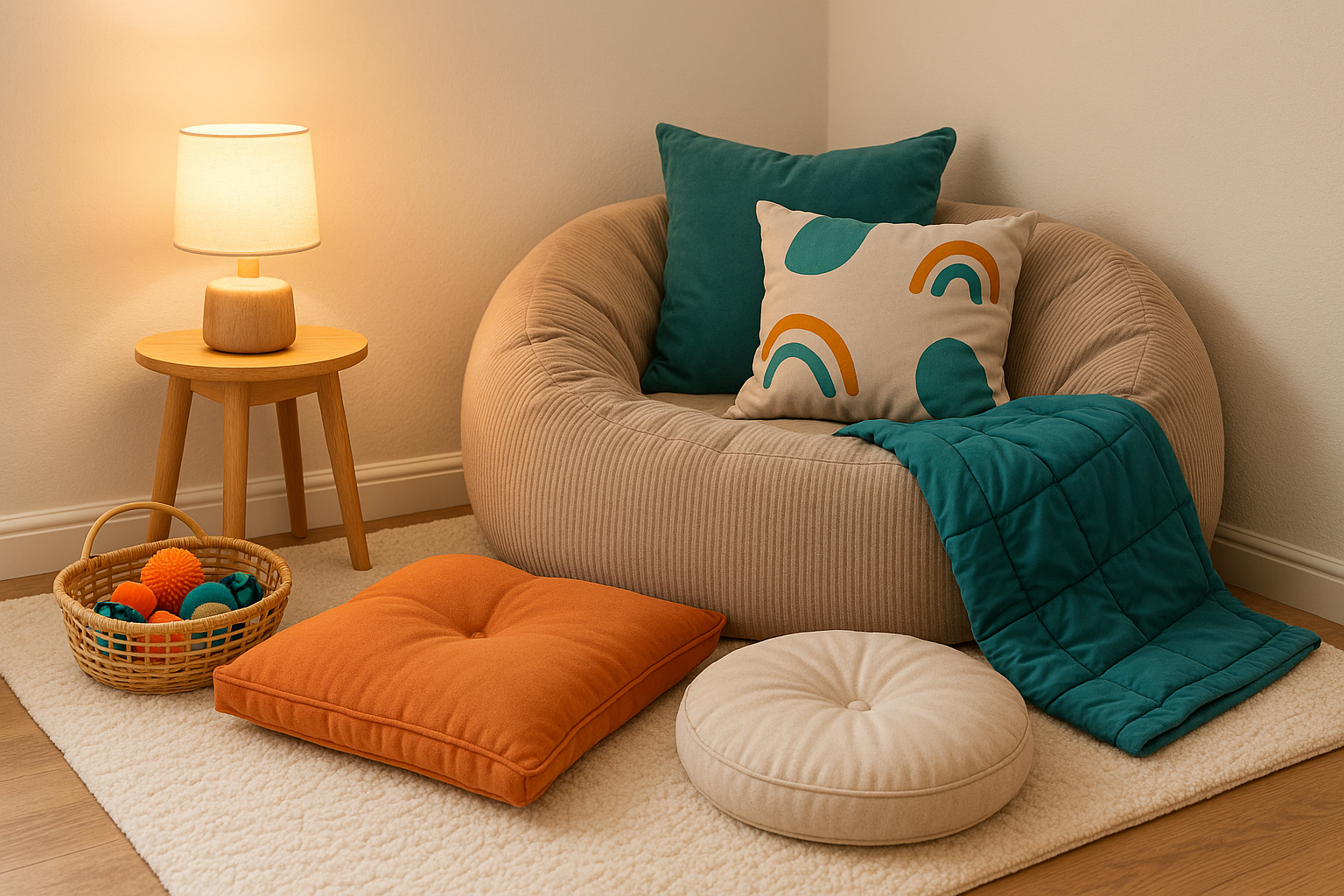How to Create a Calm‑Down Corner That Actually Works
A step‑by‑step, beginner‑friendly guide to building a safe, inviting space for regulation—plus printable checklists and tool picks.
Reading time ~8–10 minutes

What is a calm‑down corner?
A calm‑down corner is a designated spot—at home or school—where a child can step away, regulate, and return when ready. Think of it as a predictable place with age‑appropriate tools, clear visuals, and a simple routine. The goal isn’t punishment or isolation; it’s support and co‑regulation.
Why it works (benefits)
Predictability
A consistent spot with familiar tools lowers anxiety and decision fatigue.
Body‑based regulation
Tools target sensory inputs (vestibular, proprioceptive, tactile, etc.).
Skill building
Children practice noticing feelings, choosing strategies, and returning to tasks.
Step‑by‑step setup
- Pick the spot: low traffic, away from visual/sound clutter. Near adult supervision, not hidden.
- Choose seating: floor cushions or small chair; add a lap pad/blanket if helpful.
- Set lighting: warm lamp or dimmable light; avoid flicker. Consider a soft glow light.
- Stock 3–5 tools: variety across inputs (examples below). Rotate monthly.
- Add visuals: a feelings chart + 3‑step routine (e.g., “Pause → Pick a tool → Check‑in”).
- Practice when calm: rehearse the routine; model language and time limits (2–5 minutes).
- Track what works: use our app’s quick log to save what helped and when. Try the free app (launching soon).
Materials checklist
Core setup
- ✓Soft seating (cushion, bean bag, wobble stool)
- ✓Warm, steady light (lamp, string lights)
- ✓Visuals: feelings chart + mini routine
- ✓Storage basket or caddy
- ✓Timer (2–5 minutes)
Tool picks by input
- ✓Tactile: fidget cube, sensory putty, textured strip
- ✓Proprioceptive: weighted lap pad, weighted blanket
- ✓Vestibular: rocking chair, small balance board
- ✓Auditory: white noise, noise‑reducing headphones
- ✓Visual: liquid motion timer, soft projector
Tip: start small—3 tools max—and add only if needed.
Shopping? See our guides to weighted blankets, fidgets, and swings. We may earn from Amazon links (no extra cost).
Age adaptations
| Age | Keep in mind | Try |
|---|---|---|
| 0–3 | Short bursts, heavy adult co‑regulation | Lap pressure, soft textures, simple picture cards |
| 4–8 | Teach routine + choices | Feelings chart, timer, fidgets, lap pad |
| 9–12 | Privacy & dignity | Headphones, journal, discreet tools |
| 13+ | Collaborative planning | Self‑chosen lighting, weighted throw, movement break |
| Adults | Work/study integration | Desk lamp, kneadable putty, breathing prompt |
OT‑informed tips
- Co‑regulate first: name the feeling; offer the corner as a choice.
- Keep it short: 2–5 minutes beats long breaks. Return with a plan.
- One change at a time: swap a single tool and observe.
- Language matters: say “calm corner” or “regulation spot,” not “time‑out.”
- Track outcomes: log what worked using the Sensory Diet App (quick emojis).
Safety notes
- No choking hazards; avoid scented items if sensitivities/asthma.
- Secure lighting; avoid sharp edges and heavy items that can fall.
- Weighted items: ~5–10% of body weight on lap; monitor comfort.
- Supervise rocking/balance tools; set clear rules.
Troubleshooting
“They won’t use it.”
Practice when calm; add a preferred item; invite—not demand; co‑regulate beside them.
“It’s getting chaotic.”
Reduce choices to 2–3 tools; add a 3‑step visual; use a 3‑minute sand timer.
“It works at home, not at school.”
Match seating/tools to the classroom; make visuals discreet; collaborate with the teacher.
“It’s turning into a play area.”
Move toys elsewhere; keep only regulation tools; rehearse “pause → pick → check‑in.”
Printables & Visuals
Use our free visuals to set up fast:
- ✓Calm Corner Checklist (space + tools)
- ✓Calm Corner Checklist (Classroom)
- ✓5-Step Calm Corner Poster
Next step
Pick a spot, gather 3 tools, and rehearse the routine once today. Then log what worked in the Sensory Diet App.
FAQ
Is a calm‑down corner the same as time‑out?
No. A calm‑down corner supports regulation and returns the child to learning or play; it’s not a punishment.
How long should a child stay there?
Usually 2–5 minutes. The goal is a reset, not a full break from the day.
What if the child refuses?
Offer choice and co‑regulation. Practice the routine when calm and keep tools limited and predictable.
